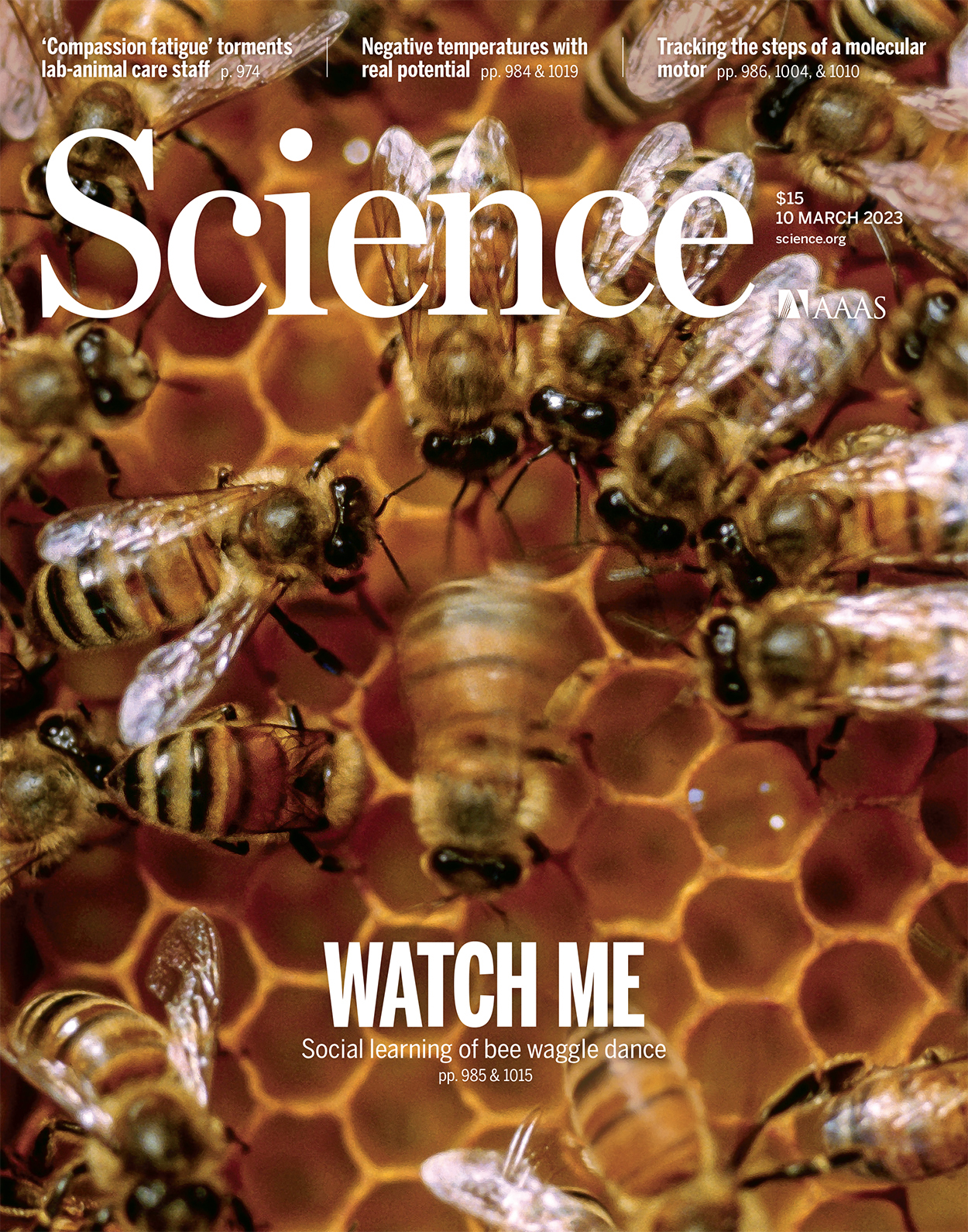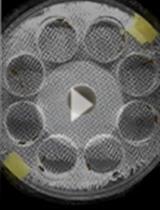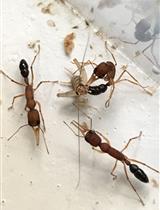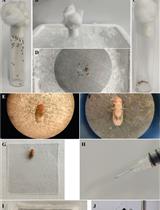- EN - English
- CN - 中文
A Method for Studying Social Signal Learning of the Waggle Dance in Honey Bees
蜜蜂摇摆舞社会信号学习的研究方法
(*contributed equally to this work) 发布: 2023年08月20日第13卷第16期 DOI: 10.21769/BioProtoc.4789 浏览次数: 1307
评审: Komuraiah MyakalaDipesh Kumar VermaRubikah Vimonish
Abstract
Honey bees use a complex form of spatial referential communication. Their waggle dance communicates to nestmates the direction, distance, and quality of a resource by encoding celestial cues, retinal optic flow, and relative food value into motion and sound within the nest. This protocol was developed to investigate the potential for social learning of this waggle dance. Using this protocol, we showed that correct waggle dancing requires social learning. Bees (Apis mellifera) that did not follow any dances before they first danced produced significantly more disordered dances, with larger waggle angle divergence errors, and encoded distance incorrectly. The former deficits improved with experience, but distance encoding was set for life. The first dances of bees that could follow other dancers had none of these impairments. Social learning, therefore, shapes honey bee signaling, as it does communication in human infants, birds, and multiple other vertebrate species. However, much remains to be learned about insects’ social learning, and this protocol will help to address knowledge gaps in the understanding of sophisticated social signal learning, particularly in understanding the molecular bases for such learning.
Key features
• It was unclear if honey bees (Apis mellifera) could improve their waggle dance by following experienced dancers before they first waggle dance.
• Honey bees perform their first waggle dances with more errors if they cannot follow experienced waggle dancers first.
• Directional and disorder errors improved over time, but distance error was maintained. Bees in experimental colonies continued to communicate longer distances than control bees.
• Dancing correctly, with less directional error and disorder, requires social learning.
• Distance encoding in the honey bee dance is largely genetic but may also include a component of cultural transmission.
Keywords: Honey bee (蜜蜂)Background
Social learning, the process of learning by observing or interacting with others, is crucial for complex behaviors and adapting these to specific environmental circumstances (Leadbeater and Chittka, 2007). Honey bee workers learn resource location and quality through the waggle dance, a sophisticated form of spatial referential communication (von Frisch, 1967). However, it was unknown if dance following could improve the performances of young waggle dancers or if the dance was entirely innate. Prior research and protocols focused on describing the waggle dance in experienced or novice bees but did not deprive them of the ability to follow waggle dances before they first danced. This deprivation, in which honey bees were unable to use social learning of waggle dancing, has not previously been described as a protocol or used to investigate waggle dancing.
Our protocol, therefore, explains how to design an experiment in which bees cannot follow other waggle dancers before they begin to dance (Dong et al., 2023). These findings indicate that social signal learning can enhance the accuracy of the waggle dance. When compared to bees that were exposed to waggle dancing, naive bees that could not observe dances prior to their first dance displayed larger divergence angle errors, signaled longer distances, and demonstrated significantly more disarray in their dances. However, when these same bees were 20 days old and had gained experience with dance following and dancing, they noticeably reduced divergence angle errors and performed more coordinated dances. Despite these improvements, they were consistently unable to accurately encode distance. These corrections in the experimental older dancers, as compared to their first dances, could be attributed to increased age, more experience following dances, additional practice with flight and foraging, or a combination thereof. Control bees only managed to reduce distance errors as they aged. Having the opportunity to observe experienced dancers before their first dance was enough for the control bees to have the lower directional errors characteristic of older, experienced bees (Dong et al., 2023).
This setup can be employed by other researchers to further explore the role of social learning in eusocial insects and its impact on communication and decision-making within colonies. Such experiments can provide a foundation for designing studies that investigate various aspects of social learning, including the following:
Comparisons across species: by conducting similar experiments on different species of eusocial insects, researchers can compare the extent and mechanisms of social learning between species, as well as the influence of genetic and environmental factors on the development of complex behaviors and communication.
Impact of social learning on colony performance: researchers can investigate the relationship between the quality of social learning and the overall performance of the colony, including foraging efficiency, resource allocation, and reproductive success. This can help to identify the benefits of social learning in colony organization and decision making.
Development of individual learning abilities: by manipulating the availability of social learning opportunities, researchers can study the development of individual learning abilities in eusocial insects and determine the importance of social learning in the acquisition and refinement of specific skills.
Neural and molecular mechanisms: investigating the neural and molecular mechanisms underlying social learning in eusocial insects can help to elucidate the cognitive and physiological processes that facilitate the acquisition of complex behaviors and communication strategies.
Social learning and colony adaptation: by examining the impact of social learning on the ability of colonies to adapt to changing environments, researchers can better understand the role of social learning in the evolution and resilience of eusocial insect societies.
Artificial intelligence and robotics: insights gained from studying social learning in eusocial insects can be applied to the development of artificial intelligence and swarm robotics in which decentralized decision-making and communication strategies are crucial for efficient problem-solving and adaptation.
By using this experimental setup as a starting point, researchers can expand our understanding of social learning in eusocial insects and its broader implications for evolution, ecology, and technology.
Location and timing
The following are instructions on the location and timing of the experiments:
Experiments were carried out at the Southwest Center for Biological Diversity, Chinese Academy of Sciences (Kunming, China). These experiments can be conducted at multiple different locations that support healthy Apis mellifera colonies.
Carry out the experiments during the months of April–June when conditions are good. Note that these months were chosen because the temperature differences between day and night are moderate and facilitate the survival of young bee colonies. The correct months to conduct such experiments will vary depending on local conditions.
Materials and reagents
Biological materials
Ten Apis mellifera colonies (five control and five experimental) were studied at a bee apiary. Queens from all colonies should be obtained from the same breeder to ensure greater genetic uniformity.
Materials
Graduated cylinder, 1,000 mL (Fisher ScientificTM, catalog number: 08-559GC) or volumetric flask with seal, 1,000 mL (Fisher ScientificTM, catalog number: 10-200G) (includes the flask and seal)
ParafilmTM wax sheet (BemisTM PM999, Fisher ScientificTM, catalog number: 13-374-12)
Reagents
Sucrose
ddH2O
Sucrose solution (see Recipes)
Recipes
Sucrose solution
Reagent Final concentration Quantity Sucrose (100%) 55% (w/v) 55 g ddH2O n/a n/a Total n/a 100 mL (final volume) To make a standard 55% (w/v) sucrose solution, weigh out 55 g of reagent-grade sucrose with an electronic balance.
Add the sucrose to a graduated cylinder or volumetric flask and then double-distilled water (ddH2O) until reaching a volume of 75 mL. You may also use distilled water.
Shake the vessel to dissolve the sugar. For a graduated cylinder, cover the opening with a Parafilm wax sheet and carefully invert it multiple times to dissolve. For a volumetric flask, use the seal that comes with the flask to seal the flask and then invert the sealed flask multiple times.
Add more ddH2O until the total volume is 100 mL.
The water should be freshly obtained but does not have an expiration date if it comes from a sterile, sealed container.
Similarly, the dry sucrose does not have an expiration date, provided that the manufacturer’s expiration date is not exceeded.
It is recommended to prepare this solution freshly each day and use it at room temperature (21 °C). Over time, this sucrose solution can begin to grow mold.
If necessary, the prepared solution can be kept at 4 °C for 24 h. Discard after 24 h.
Equipment
High-definition video camera (HDR-PJ790, Sony)
ncubator (PRX-250B, Ningbo Saifu Experimental Instrument Co., Ltd., https://www.chem17.com/product/detail/37456106.html)
Aspirator to capture bees (custom-made):
A manual aspirator is best because the suction can be controlled by the user.
To make such an aspirator, take a clear plastic cylindrical container that is 14 cm in diameter with a removable lid. Drill the lid to add two holes, spaced 10 cm apart and 1 cm in diameter.
Obtain two pieces of clear vinyl tubing that are 1 cm in outer diameter. The mouthpiece tube should be 30 cm long and the bee collection tube should be 60 cm long.
To prevent aspirating the bee into the user’s mouth, take a fine stainless-steel mesh and attach it with a 1 cm diameter hose clamp to the tube once it has been inserted through the lid into the collection container.
Take another hose clamp and similarly attach it to the bee collection tube once it has been inserted inside the lid. The clamps will keep the tubes from pulling out the lid.
Software and datasets
Tracker software (V4.91) runs on Windows, MacOS, and Linux operating systems and is free. This software is built on the Open Source Physics (OSP) Java framework and is designed for educational use. The software can be downloaded at this website: https://physlets.org/tracker/
We used JMP Pro V16.1.0 to analyze our data. A free 30-day trial of JMP is available. This software can be downloaded from this website: https://www.jmp.com/en_us/home.html
Procedure
文章信息
版权信息
© 2023 The Author(s); This is an open access article under the CC BY-NC license (https://creativecommons.org/licenses/by-nc/4.0/).
如何引用
Readers should cite both the Bio-protocol article and the original research article where this protocol was used:
- Dong, S., Lin, T., Nieh, J. C. and Tan, K. (2023). A Method for Studying Social Signal Learning of the Waggle Dance in Honey Bees. Bio-protocol 13(16): e4789. DOI: 10.21769/BioProtoc.4789.
- Dong, S., Lin, T., Nieh, J. C. and Tan, K. (2023). Social signal learning of the waggle dance in honey bees. Science 379(6636): 1015–1018.
分类
神经科学 > 行为神经科学 > 学习和记忆
您对这篇实验方法有问题吗?
在此处发布您的问题,我们将邀请本文作者来回答。同时,我们会将您的问题发布到Bio-protocol Exchange,以便寻求社区成员的帮助。
Share
Bluesky
X
Copy link












